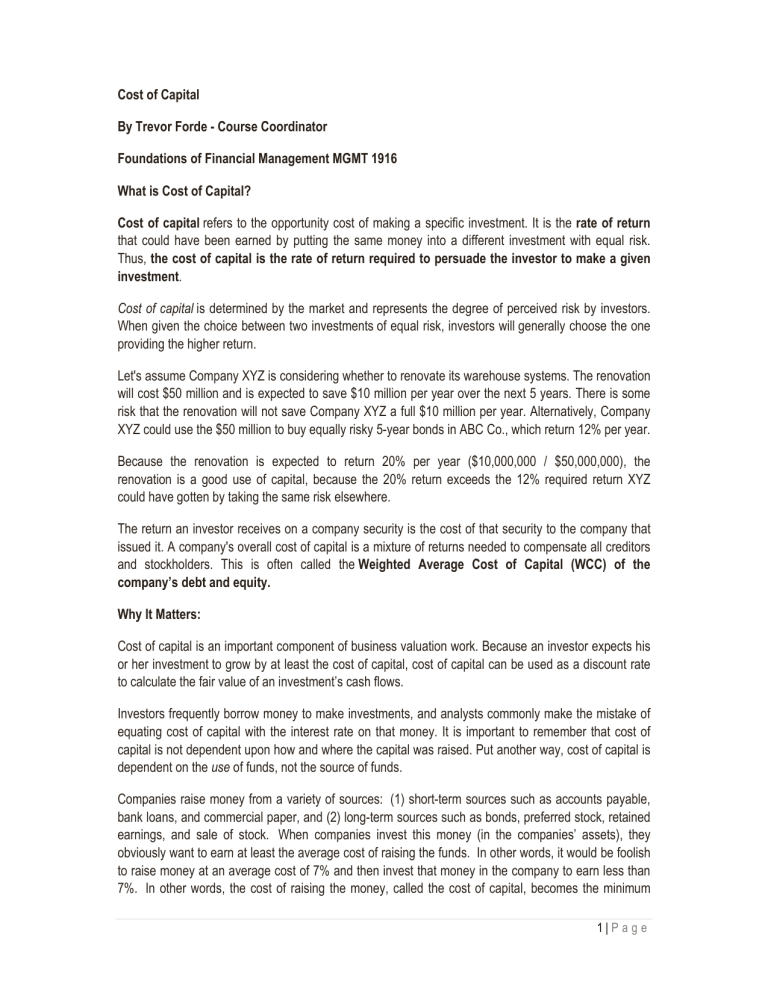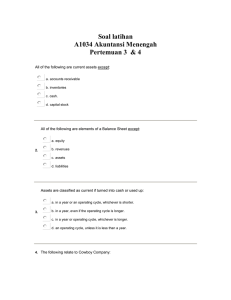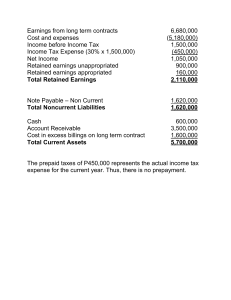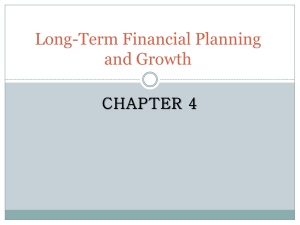
Cost of Capital By Trevor Forde - Course Coordinator Foundations of Financial Management MGMT 1916 What is Cost of Capital? Cost of capital refers to the opportunity cost of making a specific investment. It is the rate of return that could have been earned by putting the same money into a different investment with equal risk. Thus, the cost of capital is the rate of return required to persuade the investor to make a given investment. Cost of capital is determined by the market and represents the degree of perceived risk by investors. When given the choice between two investments of equal risk, investors will generally choose the one providing the higher return. Let's assume Company XYZ is considering whether to renovate its warehouse systems. The renovation will cost $50 million and is expected to save $10 million per year over the next 5 years. There is some risk that the renovation will not save Company XYZ a full $10 million per year. Alternatively, Company XYZ could use the $50 million to buy equally risky 5-year bonds in ABC Co., which return 12% per year. Because the renovation is expected to return 20% per year ($10,000,000 / $50,000,000), the renovation is a good use of capital, because the 20% return exceeds the 12% required return XYZ could have gotten by taking the same risk elsewhere. The return an investor receives on a company security is the cost of that security to the company that issued it. A company's overall cost of capital is a mixture of returns needed to compensate all creditors and stockholders. This is often called the Weighted Average Cost of Capital (WCC) of the company’s debt and equity. Why It Matters: Cost of capital is an important component of business valuation work. Because an investor expects his or her investment to grow by at least the cost of capital, cost of capital can be used as a discount rate to calculate the fair value of an investment’s cash flows. Investors frequently borrow money to make investments, and analysts commonly make the mistake of equating cost of capital with the interest rate on that money. It is important to remember that cost of capital is not dependent upon how and where the capital was raised. Put another way, cost of capital is dependent on the use of funds, not the source of funds. Companies raise money from a variety of sources: (1) short-term sources such as accounts payable, bank loans, and commercial paper, and (2) long-term sources such as bonds, preferred stock, retained earnings, and sale of stock. When companies invest this money (in the companies’ assets), they obviously want to earn at least the average cost of raising the funds. In other words, it would be foolish to raise money at an average cost of 7% and then invest that money in the company to earn less than 7%. In other words, the cost of raising the money, called the cost of capital, becomes the minimum 1|Page desired rate of return for investing the money. If the cost of capital is 8.5%, then the minimum desired rate of return for investing the money is 8.5%. However, while it might be interesting to calculate the average cost of raising money from all these sources, it may not be very useful. This is because companies rarely finance their assets by raising money across the board from all these sources. However, companies do follow the matching principle, which says that short-term assets should be financed with short-term liabilities and long-term assets should be financed with long-term sources. While we might be able to survive a mistake in purchasing short-term assets, mistakes in purchasing long-term assets stay with us much longer and are more expensive. Therefore, we want to ensure that fixed assets earn at least the cost of financing them. If we want to avoid making a major mistake like this, it is particularly important that we calculate accurately the cost of capital raised from long-term sources. The most accurate term for this would be "the cost of long-term capital" but it is generally shortened to the term "cost of capital." How to Calculate the Cost of Capital The cost of capital is simply a weighted average of the cost of the individual sources (i.e., bonds, preferred stock, retained earnings, and sale of new common stock). For example, assume that you raise 40% of your money in the form of debt, 20% in preferred stock, and 40% in common equity. Given the cost of each shown in the table below, the weighted cost of capital for the company would be 7.0%. Proportion * Cost = Wt. Cost 0.40 * 5% = 2.0% 0.20 * 7% = 1.4% 0.40 * 9% = 3.6% Cost of Capital = 7.0% Let’s look at a few details for calculating the cost of each component. Cost of Debt Debt is special in the sense that its interest payments are tax-deductible. While this is a good thing, it does present a problem when comparing its cost with the cost of the other components, whose costs are not tax-deductible. So what is the solution? Simply place the cost of debt on an after-tax basis – the same basis as the other sources. We do this by simply multiplying the interest rate times [1 - the tax rate]. For example, if a company pays an interest rate of 8% and is in the 40% tax bracket, the after-tax cost of debt would be: 2|Page Cost of debt = interest rate * (1 – tax rate) Cost of debt = Cost of debt = 8% * (1 – 0.40) 4.8% Cost of Preferred Stock The cost of money raised by selling preferred stock is, generically, the dollar cost divided by the amount of money raised. If a company sells $1 million worth of preferred stock, pays the investment banker $100,000 for its help with the sale, and pays $70,000 in annual preferred stock dividends, the cost of preferred stock is equal to: Cost of preferred stock = preferred stock dividends net proceeds from sale of preferred stock Cost of preferred stock = preferred stock dividends preferred stock - flotation cost Cost of preferred stock = $70,000 $1,000,000 - $100,000 Cost of preferred stock = 7.78% Cost of Retained Earnings Stockholders let the company’s management keep some of the earnings and reinvest them back into the company (rather than paying it to them in the form of dividends). This does not mean that these retained earnings are free however – the stockholders still expect to earn a rate of return on the company’s investment of this money. The rate of return that the company must earn on the investment of this money (in order to keep the shareholders happy) is called the cost of retained earnings. The formula for calculating the cost of retained earnings is shown below: Cost of retained earnings = next year's dividend price of common stock Cost of retained earnings = $2.00 $100.00 + 9.00% Cost of retained earnings = 2.00% + 9.00% Cost of retained earnings = 11.00% + future growth rate of dividends 3|Page Cost of New Equity The cost of raising money through the sale of new common stock is the same as the cost of retained earnings, with one exception: flotation costs. Money earned in the company’s operations (i.e., retained earnings) is readily available without paying any outside agency; money raised from outside the company often comes with commissions and fees (i.e., flotation fees) attached. The formula for the cost of new common equity is as follows: next year's dividend Cost of new equity = price of common stock x (1 - % flotation cost) + future growth rate of dividends $2.00 Cost of new equity = $100.00 x (1 - 20%) Cost of new equity = Cost of new equity = $2.00 $100.00 x 80% $2.00 $80.00 Cost of new equity = 2.50% Cost of new equity = 11.50% + 9.00% + 9.00% + 9.00% + 9.00% Weighted Marginal Cost of Capital Assume that Genuine Products, Inc. is raising money for expansion of its operation. It has part of the money already set aside in the form of cash from this year's addition to retained earnings. In order to stay at its optimal capital structure, it has decided to raise the money in the following proportions: 40% debt, 10% preferred stock, 20% retained earnings, and 30% from the sale of new common stock. Assuming that the company can raise money at the costs calculated above, the company's marginal cost of capital will be: Proportion * Cost = Wt. Cost 0.40 * 4.80% = 1.92% 0.10 * 7.78% = 0.78% 0.20 * 11.00% = 2.20% 0.30 * 11.50% = 3.45% Cost of capital = 8.35% 4|Page





